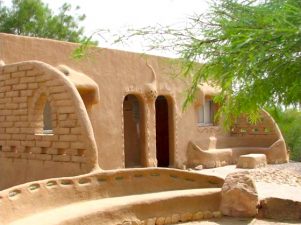 How do the Syrian beehive-shaped houses made out of mud manage to stay so cool in extreme desert conditions?
How do the Syrian beehive-shaped houses made out of mud manage to stay so cool in extreme desert conditions?
As war and conflict tear through Syria, we take a look at the ancient earthen beehive-shaped houses on the edge of the country which have been wowing visitors for centuries. We have covered these amazing traditional Syrian houses which manage to stay cool in the desert without air conditioning before, but I couldn’t resist showcasing these amazing feats of architecture again. Their iconic shape and eco-friendly architecture is definitely something which needs to be celebrated time and time again.
According to Earth Architecture, half of the world’s population live of work in buildings constructed of earth. So rather than seeing earth architecture as something of the past we must accept that in some way and in some places, earth architecture still rules supreme. Mud, dirt and straw are the oldest building material on the planet as they are widely available, cheap and relatively easy to manipulate and build with.
Other earthen buildings in the Middle East include adobe (mud brick) houses in the Marshes of Iraq, the tallest city of Shibam in Yemen, the city of Bam in Iran as well as the eco-friendly architecture of the Egyptian architect Hassan Fathy.
The beehive houses is an ancient dwelling with evidence of its existence going back to 3,700 B.C. There have been recorded examples of their construction in Palestine, Cyprus and Turkey although it is only in Syria that they have persisted to this day. The Syrian beehive-houses are located on the edge of the Syrian desert with whole beehive villages in Aleppo and are used for storage as well as housing.
It is believed that the conical homes continue to be built in areas of Syria as there are no alternative building materials available which were better suited to the environment. Beehive homes are built using mud bricks which are stacked in a conical shape which allows hot air to travel upwards allowing the ground floor where the residents live to stay cool.
To keep the air cool, these houses rarely have windows which also protects the residents from the desert winds. The conical dome of the beehive houses also allows the rare torrential rains to flow down without exposing the mud to too much water.
:: All the amazing images are via james.gordon6108/flickr (In 2023 his stream is offline)
For more on Mud/Earth Architecture see:
Earth Architecture All The Way To Timbuktu
Mud Structures of the Muslim World: Spectacular and Sustainable
Bustan’s Mud Huts With Plasma Screens








i am looking for any available job you can offer me i have many experience please so i am waiting for thankx
Unfortunately these are not really earthquake safe. The construction material will need to be modified, I think.